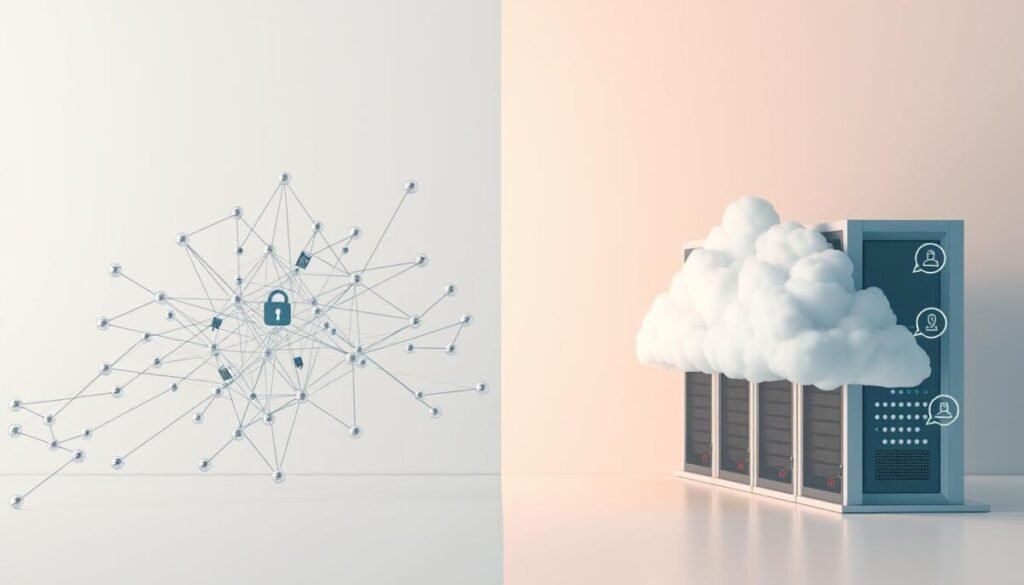Have you ever wondered how your data stays safe in a world full of cyber threats? Traditional methods often fall short, leaving vulnerabilities exposed. But what if there was a way to protect your information that’s both innovative and reliable?
Blockchain technology is changing the game. It offers a decentralized approach to keeping your data secure. Instead of relying on a single point of failure, your information is spread across a network. This makes it nearly impossible for hackers to breach.
Decentralized networks also bring cost savings. Studies show that using this method can reduce expenses by up to 90% compared to traditional providers. Plus, advanced encryption standards like AES-256 ensure your data remains private.
Enterprises and individuals are already adopting this technology. Platforms like Filecoin and Storj are leading the way. They offer tamper-proof solutions that are both efficient and secure. Ready to explore how this can benefit you? Let’s dive in. As the demand for data privacy and protection rises, understanding how to secure cloud storage has become essential for businesses and individuals alike. Utilizing decentralized storage solutions can not only enhance data security but also reduce dependency on traditional cloud providers. By leveraging these innovative platforms, you can ensure your valuable information remains safeguarded against unauthorized access. Moreover, understanding how to retrieve deleted cloud files is crucial for anyone utilizing these technologies. Even with robust security measures in place, accidental deletions can occur, making recovery processes vital. By mastering these aspects, users can take full control of their data in a decentralized environment.
Key Takeaways
- Blockchain technology enhances data protection through decentralization.
- Decentralized networks eliminate single points of failure.
- Cost savings of up to 90% compared to traditional providers.
- Advanced encryption standards like AES-256 ensure data privacy.
- Real-world adoption by enterprises and individuals is growing.
How Blockchain Transforms Cloud Storage Security
Data protection has evolved, and blockchain is at the forefront of this transformation. Traditional systems often rely on centralized servers, which can be vulnerable to attacks. Blockchain, however, uses a decentralized network to distribute data across multiple nodes. This approach eliminates single points of failure, making it much harder for hackers to compromise your information.
The Role of Decentralized Networks in Data Protection
Decentralized networks spread data across numerous nodes, ensuring redundancy and resilience. For example, platforms like Storj break files into 80 pieces, with only 29 needed for recovery. This sharding process, combined with Reed-Solomon erasure coding, ensures data remains accessible even if some nodes fail.
Node verification is another critical feature. In networks like Filecoin and Sia, nodes must prove their reliability before participating. This process ensures that only trustworthy nodes handle your data, enhancing overall security.
Why Encryption and Sharding Make Blockchain Storage Tamper-Proof
Encryption is the backbone of blockchain’s security. Files are encrypted using AES-256 with Galois/Counter Mode, ensuring they remain confidential. Cryptographic fingerprinting adds another layer of protection, making unauthorized modifications easily detectable.
Sharding further enhances security by splitting files into smaller pieces. These pieces are distributed across the network, and only the file owner has the key to reassemble them. This method ensures that even if one piece is compromised, the entire file remains secure.
| Feature | Traditional Systems | Blockchain Systems |
|---|---|---|
| Data Distribution | Centralized servers | Decentralized nodes |
| Encryption | Standard protocols | AES-256 with GCM |
| Redundancy | Limited backups | Sharding and erasure coding |
| Tamper-Proofing | Audit trails | Immutable ledger |
Blockchain’s immutable ledger ensures that all transactions are recorded permanently. This transparency not only enhances security but also simplifies compliance and auditing. With these features, blockchain is setting a new standard for data protection.
Cloud Storage with Blockchain Security: Key Advantages
Why are more organizations turning to decentralized systems for their data needs? The answer lies in the unique benefits these solutions offer. From significant cost savings to enhanced privacy and resilience, decentralized systems are redefining how we approach data storage.

Cost Savings Compared to Traditional Cloud Providers
One of the most compelling advantages is the cost efficiency. Traditional cloud providers like AWS charge $23/TB/month, while decentralized platforms like Sia offer the same service for just $0.80/TB. Storj provides fixed pricing at $4/TB, making it a budget-friendly option for businesses.
- FIL tokens vs fiat currencies offer flexible payment models.
- MaidSafe’s “pay once, store forever” model eliminates recurring fees.
- Resource tests ensure only reliable nodes participate, reducing operational costs.
Enhanced Privacy Through User-Controlled Encryption Keys
Privacy is a top priority in decentralized systems. Users retain full control over their encryption keys, ensuring that no third party can access their data. Platforms like Sia use end-to-end encryption, while Vult employs proxy re-encryption for secure file sharing.
- Private key ownership prevents provider access.
- Encryption key management best practices ensure data confidentiality.
- Compliance with GDPR and HIPAA benefits healthcare and finance sectors.
Resilience Against Single Points of Failure
Decentralized systems excel in redundancy and resilience. Sia’s 10-of-30 segment recovery system ensures data remains accessible even if some nodes fail. The Safe Network’s 3x redundancy and sharding across nodes provide robust protection against data loss.
- Blockchain uptime statistics outperform traditional cloud providers.
- Repair mechanisms and distributed storage enhance data availability.
- Immutable ledgers ensure data integrity and prevent unauthorized access.
These benefits make decentralized systems a game-changer for modern data storage. Whether you’re an individual or an organization, the advantages are clear: lower costs, enhanced privacy, and unmatched resilience.
How Decentralized Storage Networks Operate
Ever wondered how data is managed across decentralized systems? These networks rely on advanced techniques like sharding and distributed ledger technology to ensure efficiency and security. By breaking files into smaller pieces and spreading them across multiple nodes, they eliminate single points of failure.

Breaking Down Sharding and Distributed Ledger Technology
Sharding is a key process in decentralized systems. For example, Storj breaks files into 80 pieces, with only 29 needed for recovery. This ensures redundancy and resilience. Distributed ledger technology records every transaction, making the system transparent and tamper-proof.
Platforms like Filecoin require Linux-only nodes, ensuring technical standards are met. Arweave uses a one-time payment model with AR tokens, offering a unique way to store data permanently. These methods provide businesses with reliable and cost-effective solutions.
The Peer-to-Peer Model: Matching Renters with Hosts
Decentralized networks operate on a peer-to-peer basis. Renters and hosts connect directly, eliminating intermediaries. Hosts are incentivized with cryptocurrency, ensuring they maintain high standards. For instance, Sia uses proof-of-storage algorithms to verify host reliability.
This model also allows for customizable data retrieval speeds. Platforms like Utopia use AES-256 encryption to secure data, while BTFS operates on the TRON network. These features make decentralized systems a practical choice for modern data needs.
Top Blockchain-Based Storage Platforms to Consider
Exploring the best decentralized platforms can transform how we manage data. These platforms offer unique features tailored to different needs, from cost efficiency to permanent data retention. Let’s dive into the leaders in this space.

Filecoin: A Leader in Decentralized Marketplaces
Filecoin stands out with its $257 million ICO record, making it one of the most funded projects in the space. It requires Linux or macOS nodes, ensuring high technical standards. Filecoin’s decentralized marketplace allows users to rent storage space efficiently.
Its architecture combines blockchain and distributed ledger technology, offering robust security and transparency. Filecoin also supports custom integrations through APIs, making it a versatile choice for developers.
Sia: Open-Source Storage with Competitive Pricing
Sia is known for its open-source model and affordability. It splits files into 30 segments using Reed-Solomon erasure coding, ensuring redundancy. Sia supports Windows, Linux, and macOS, making it accessible to a wide range of users.
Its competitive pricing starts at $0.80/TB, significantly lower than traditional providers. Sia also uses proof-of-storage algorithms to verify host reliability, enhancing overall security.
Storj: Enterprise-Grade Security with Fixed Costs
Storj offers enterprise-grade security with AES-256 encryption and S3 compatibility. It provides a 25GB free tier, making it an accessible option for new users. Storj’s fixed pricing at $4/TB ensures predictable costs for businesses.
Its architecture leverages a decentralized network, enhancing resilience against failures. Storj also offers SLA guarantees, ensuring high service levels for enterprises.
Arweave: Permanent Storage for Immutable Data
Arweave’s permaweb provides an immutable environment for permanent data storage. It uses a one-time payment model with AR tokens, offering a sustainable solution for long-term data needs. Arweave’s 100% community-operated network ensures transparency and reliability.
Its endowment model promotes data availability, making it ideal for archival purposes. Arweave’s unique approach sets it apart in the decentralized storage landscape.
| Platform | Architecture | Pricing | Key Features |
|---|---|---|---|
| Filecoin | Blockchain + DLT | Market-based | Linux/macOS nodes, API support |
| Sia | Blockchain | $0.80/TB | 30-segment sharding, open-source |
| Storj | Decentralized Network | $4/TB | S3 compatibility, 25GB free tier |
| Arweave | Permaweb | One-time payment | Immutable data, endowment model |
These platforms offer diverse solutions for modern data needs. Whether you prioritize cost, security, or permanence, there’s a decentralized option for every user. Many users appreciate the flexibility these platforms provide, allowing for seamless integration with existing workflows. Additionally, they often feature secure cloud storage options that ensure sensitive information remains protected while being easily accessible. As the demand for reliable data solutions continues to grow, these decentralized systems will likely play an increasingly vital role in the digital landscape.
Blockchain vs. Traditional Cloud Storage: A Direct Comparison
When it comes to safeguarding data, the debate between traditional and decentralized systems is heating up. Both approaches have their strengths, but blockchain is emerging as a game-changing alternative. Let’s break down the key differences.

One of the most significant advantages of blockchain is cost efficiency. Studies show it can reduce expenses by up to 90% compared to traditional providers. For example, AWS relies on 3x replication, while blockchain systems like Sia offer 10x+ redundancy. This ensures better resilience and lower costs.
Security is another area where blockchain shines. Traditional systems use centralized encryption key management, which can be a vulnerability. In contrast, blockchain gives users full control over their keys, enhancing privacy and protection.
Decentralized systems also excel in data sovereignty. Users retain control over their data, even across borders. This is a stark contrast to traditional storage systems, where providers often have access to user information.
Ransomware resistance is another key benefit. Blockchain’s decentralized nature makes it harder for attackers to access all data copies. This adds an extra layer of protection compared to centralized infrastructure.
| Feature | Traditional Systems | Blockchain Systems |
|---|---|---|
| Cost | High (e.g., AWS $23/TB) | Low (e.g., Sia $0.80/TB) |
| Redundancy | 3x replication | 10x+ redundancy |
| Key Management | Centralized | Decentralized |
| Ransomware Resistance | Vulnerable | Highly resistant |
| Data Sovereignty | Provider-controlled | User-controlled |
Disaster recovery is another area where blockchain outperforms. Data stored across multiple nodes reduces the risk of loss, unlike traditional systems reliant on regional data centers. This ensures better availability and reliability.
Scalability is also a key consideration. Blockchain solutions like Züs address this with high-speed performance, while traditional systems often face limitations due to centralized infrastructure.
In summary, blockchain offers a compelling alternative to traditional methods. From cost savings to enhanced security, it’s clear why more organizations are making the switch.
The Future of Secure Data Storage Lies in Decentralization
The way we protect information is evolving rapidly, and decentralization is leading the charge. By 2025, decentralized systems are projected to capture a significant market share, driven by their cost efficiency and resilience. This shift is not just about technology but also about adapting to new challenges like quantum computing and evolving regulations.
Hybrid architectures combining traditional and decentralized systems are emerging as a practical solution. These models leverage the strengths of both approaches, offering flexibility and scalability. Additionally, AI-driven optimization is making these systems smarter, ensuring efficient resource use and faster data retrieval.
Web3 integration is another game-changer, enabling seamless interactions across decentralized networks. Edge computing further enhances this by reducing latency and improving user experiences. Together, these advancements are shaping a future where data is not only secure but also more accessible and user-controlled.
As enterprises begin migrating to decentralized systems, tokenization of assets and zero-knowledge proofs are becoming critical. These innovations ensure transparency and privacy, making decentralized storage a reliable choice for businesses and individuals alike.



